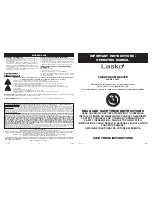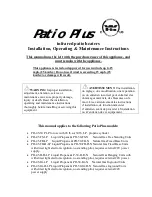
Instruction manual ADMR
13
gis
2.4.2
Water temperature protection
The electronic controller uses temperatures sensors T1 (7) and T2 (13) to
monitor three temperatures that are important for safety. The table explains the
functioning of the temperature sensors.
Temperature protection
2.4.3
Flue gas backflow safeguard
The flue gases are discharged to the outside via the draught diverter (33) and
the chimney. To prevent flue gases accumulating in the boiler room, the
discharge of flue gases is monitored by a flue gas sensor (34). The flue gas
sensor is mounted in the draught diverter.
2.4.4
Flame probe
To ensure that no gas can flow when there is no combustion, the water heater
is fitted with a flame probe (21). The electronic controller uses this probe to
detect the presence of a flame, by means of ionisation detection. The electronic
controller closes the gas control the instant it detects that there is a gas flow but
no flame.
2.5
Safety of the
installation
In addition to the appliance's standard built-in safety monitoring, the appliance
must also be protected by an expansion vessel, expansion valve, pressure
reducing valve, non-return valve and a T&P valve.
The use of an expansion vessel, expansion valve and/or pressure reducing
valve depends on the type of installation: unvented or vented.
2.5.1
Unvented installation
With an unvented installation, an expansion valve valve and expansion vessel
prevent the buildup of excessive pressure in the tank. This prevents damage
being caused to the enamelled coating (in the appliance) or to the tank. A non-
return valve prevents excessive pressure buildup in the water supply system.
This valve also prevents water from flowing backwards from the tank into the
cold water supply system. The pressure reducing valve protects the installation
against an excessively high water supply pressure (> 8 bar). These components
are fitted to the cold water pipe (3.6 "Water connections, Vented").
2.5.2
Vented installation
With a vented installation, excess pressure is taken up by the open cold water
head tank. The height of the head tank determines the working pressure in the
water heater, which may not exceed 8 bar. The installation must also be fitted
with a vent pipe from the hot water pipe, that opens into the cold water tank.
Ideally, the vent pipe should discharge into a separate tundish/drain or
otherwise to the open cold water head tank. The water heater should also be
fitted on the hot water side with a stop valve (3.7.3 "Hot water side").
Protection
Description
Against frost
(T1 < 5 °C or T2 < 5 °C)
The frost protection cuts in. The water is heated to 20 °C.
For maximum water temperature
(T1 > 85 °C or T2 > 85 °C)
The high-limit safeguard serves to prevent overheating and/or excessive
formation of scale in the appliance. If the high-limit safeguard is activated, the
heating is stopped. This causes the water in the tank to cool down. Once the
water has cooled sufficiently (T1 < 78 °C), the electronic controller resets the
appliance.
For extra safety
(T1 > 93 °C or T2 > 93 °C)
A lockout error of the water heater controller takes place. The controller must
be manually reset before the appliance can resume operation (8.3 "Error
conditions"). The reset may only be performed if T
1
<78 °C.
Summary of Contents for ADMR - 40
Page 4: ...4 Instruction manual ADMR gis ...
Page 10: ...Introduction 10 Instruction manual ADMR 1 gis ...
Page 54: ...Shutting down 54 Instruction manual ADMR 10 gis ...
Page 62: ...Main menu 62 Instruction manual ADMR 11 gis ...
Page 76: ...is Instruction manual ADMR 76 ...
Page 78: ...Maintenance frequency 78 Instruction manual ADMR 14 is ...
Page 84: ...Performing maintenance 84 Instruction manual ADMR 15 s ...
Page 92: ...Appendices 92 Instruction manual ADMR 17 is ...
Page 94: ...Instruction manual ADMR 94 ...














































